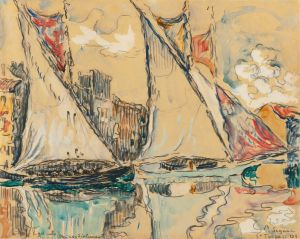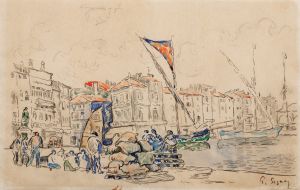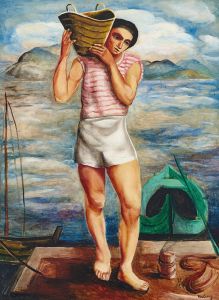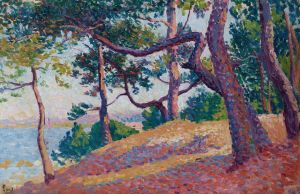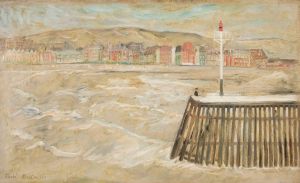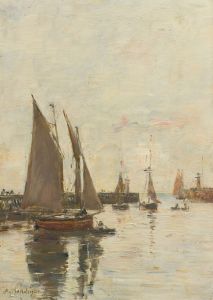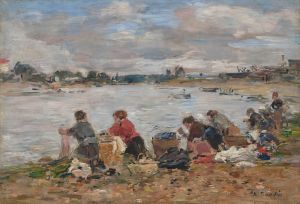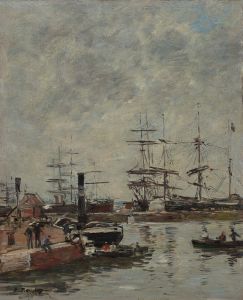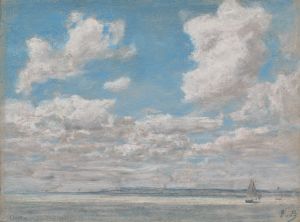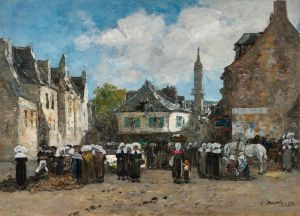
L’escadre devant Villefranche
A hand-painted replica of Eugène Boudin’s masterpiece L’escadre devant Villefranche, meticulously crafted by professional artists to capture the true essence of the original. Each piece is created with museum-quality canvas and rare mineral pigments, carefully painted by experienced artists with delicate brushstrokes and rich, layered colors to perfectly recreate the texture of the original artwork. Unlike machine-printed reproductions, this hand-painted version brings the painting to life, infused with the artist’s emotions and skill in every stroke. Whether for personal collection or home decoration, it instantly elevates the artistic atmosphere of any space.
Eugène Boudin, a pioneering French painter known for his seascapes and beach scenes, created the painting "L’escadre devant Villefranche" in 1892. Boudin was one of the first French landscape painters to paint outdoors, or en plein air, which significantly influenced the Impressionist movement. His work is characterized by a keen observation of light and atmosphere, capturing the transient effects of weather and time of day.
"L’escadre devant Villefranche" depicts a naval squadron off the coast of Villefranche-sur-Mer, a picturesque commune on the French Riviera. This location, with its deep natural harbor, has historically been of strategic maritime importance. Boudin's choice of subject reflects his fascination with the sea and maritime life, themes that recur throughout his oeuvre. The painting showcases his ability to render the subtle interplay of light on water and the sky, a hallmark of his style.
In this work, Boudin captures the serene yet dynamic scene of ships anchored in the bay, set against the backdrop of the Mediterranean landscape. The composition is balanced, with the ships positioned in a way that leads the viewer's eye across the canvas, creating a sense of depth and movement. The sky, a vital element in Boudin's paintings, is depicted with soft, diffused clouds, suggesting a gentle breeze and the calmness of the sea.
Boudin's technique involves the use of loose, fluid brushstrokes that convey the ephemeral nature of the scene. His palette is typically muted, with a focus on blues, grays, and whites, which enhances the atmospheric quality of the painting. This approach allows him to effectively capture the luminosity of the Mediterranean light, a feature that fascinated many artists of his time.
The painting is a testament to Boudin's skill in portraying the natural world with authenticity and sensitivity. His ability to depict the nuances of light and atmosphere influenced many of his contemporaries, including Claude Monet, who once referred to Boudin as his "master." Boudin's work laid the groundwork for the Impressionist movement, emphasizing the importance of capturing the fleeting effects of light and color in nature.
"L’escadre devant Villefranche" is part of Boudin's broader body of work that celebrates the beauty and tranquility of coastal life. His paintings are appreciated for their ability to evoke a sense of place and moment, transporting the viewer to the serene shores of the French Riviera. Today, Boudin's works are held in high regard and can be found in major museums and collections worldwide, where they continue to be celebrated for their contribution to the development of modern landscape painting.
In summary, Eugène Boudin's "L’escadre devant Villefranche" is a quintessential example of his mastery in capturing the essence of maritime scenes. Through his innovative approach to painting en plein air and his focus on light and atmosphere, Boudin has secured his place as a significant figure in the history of art, influencing generations of artists who followed.





